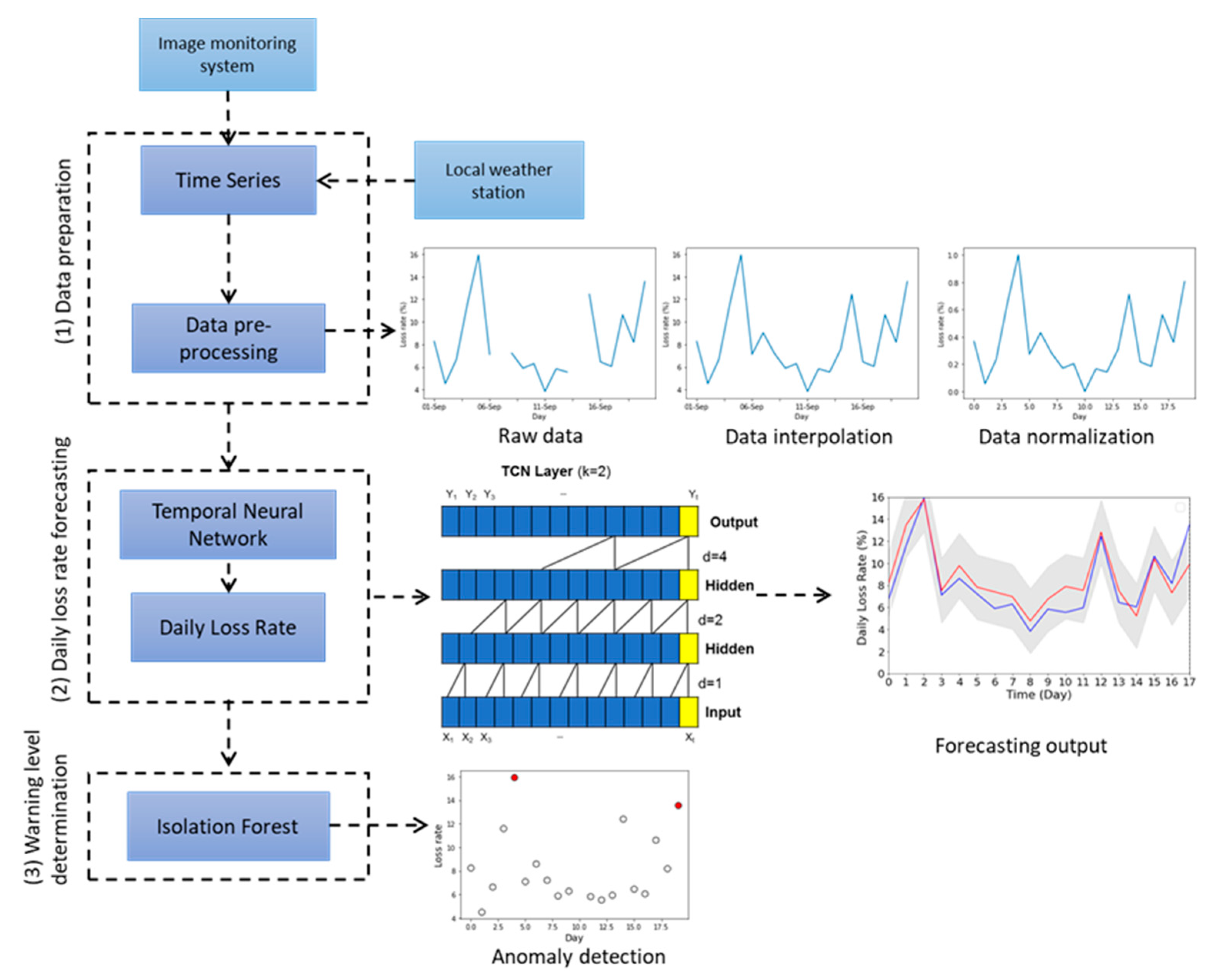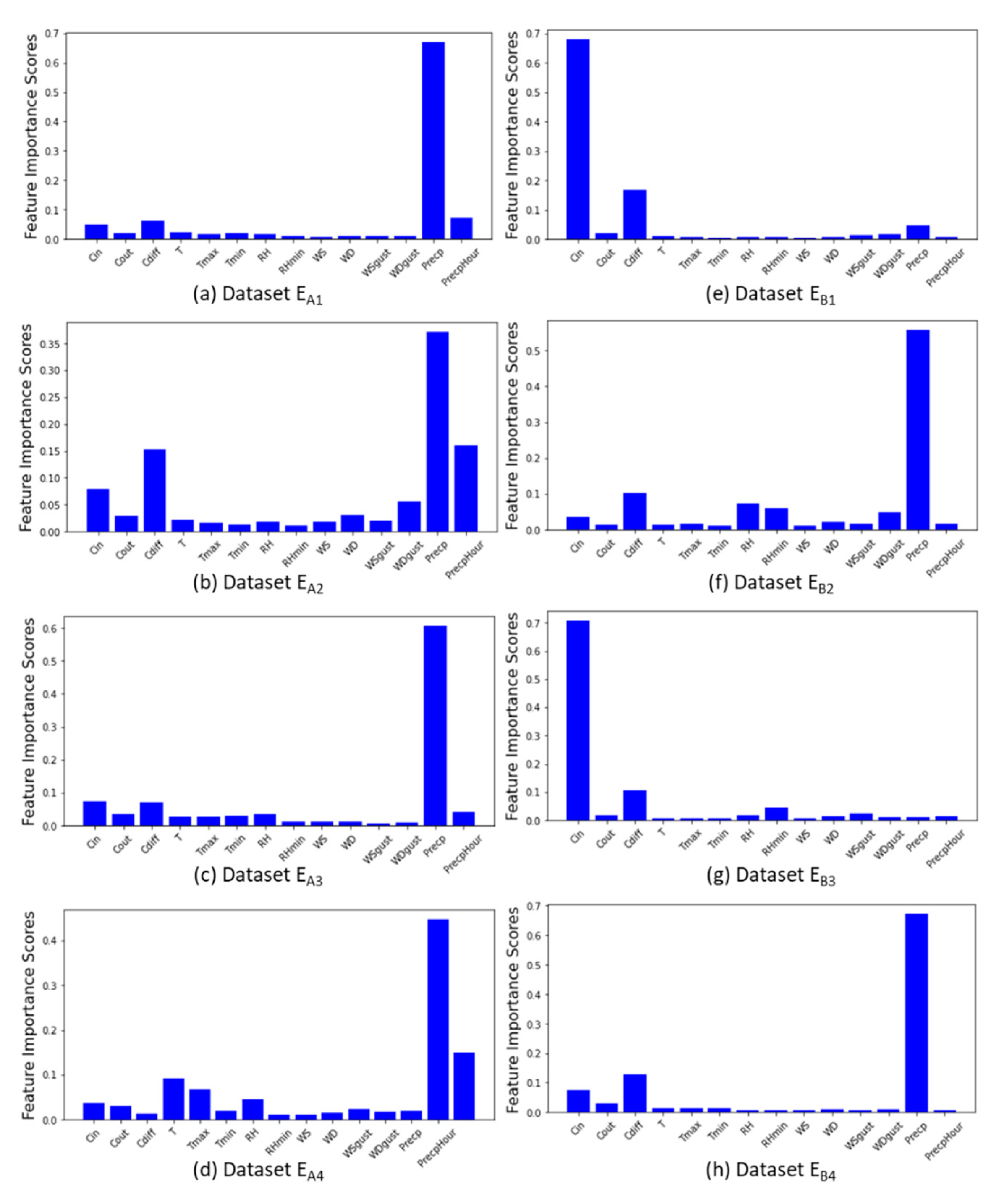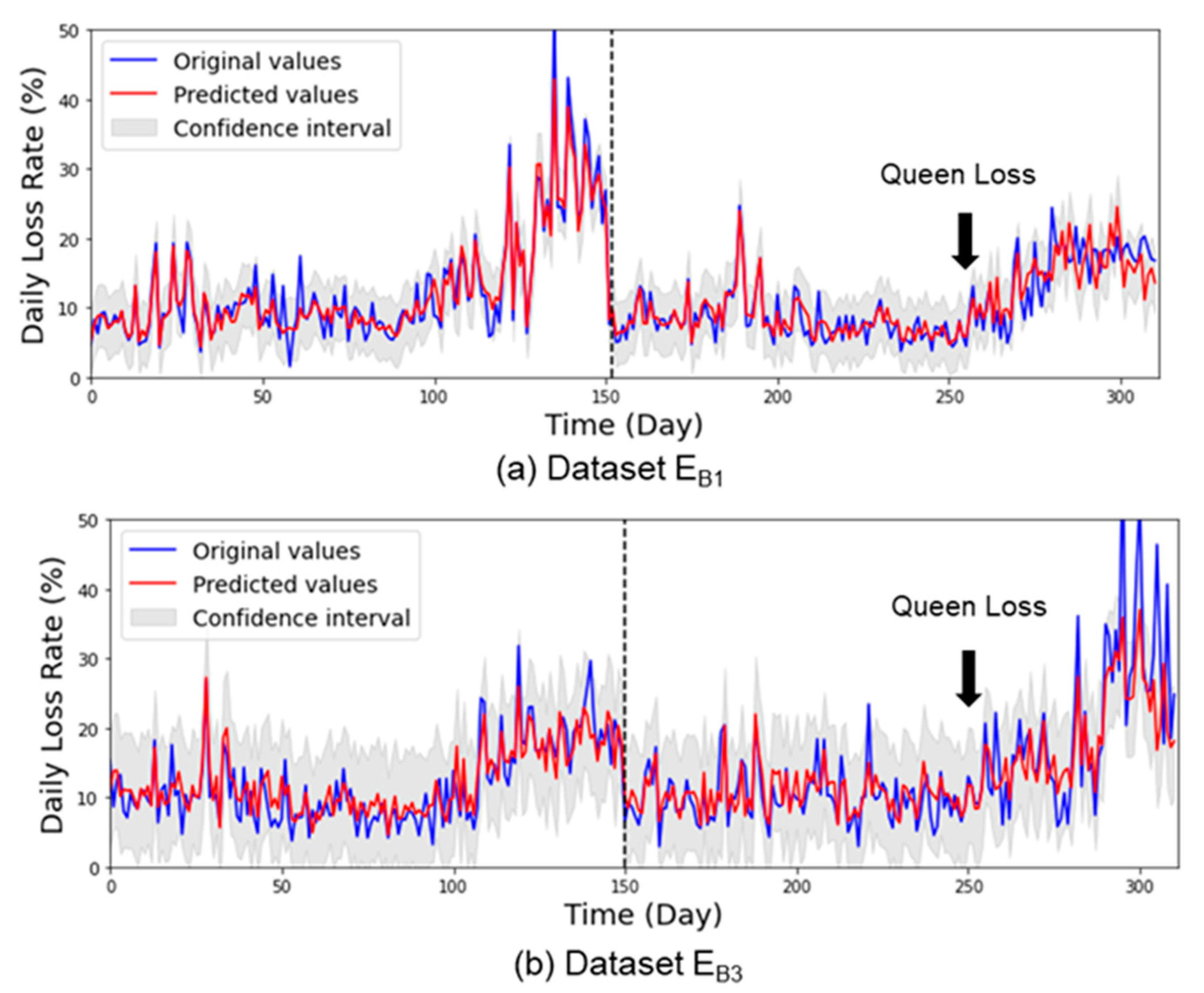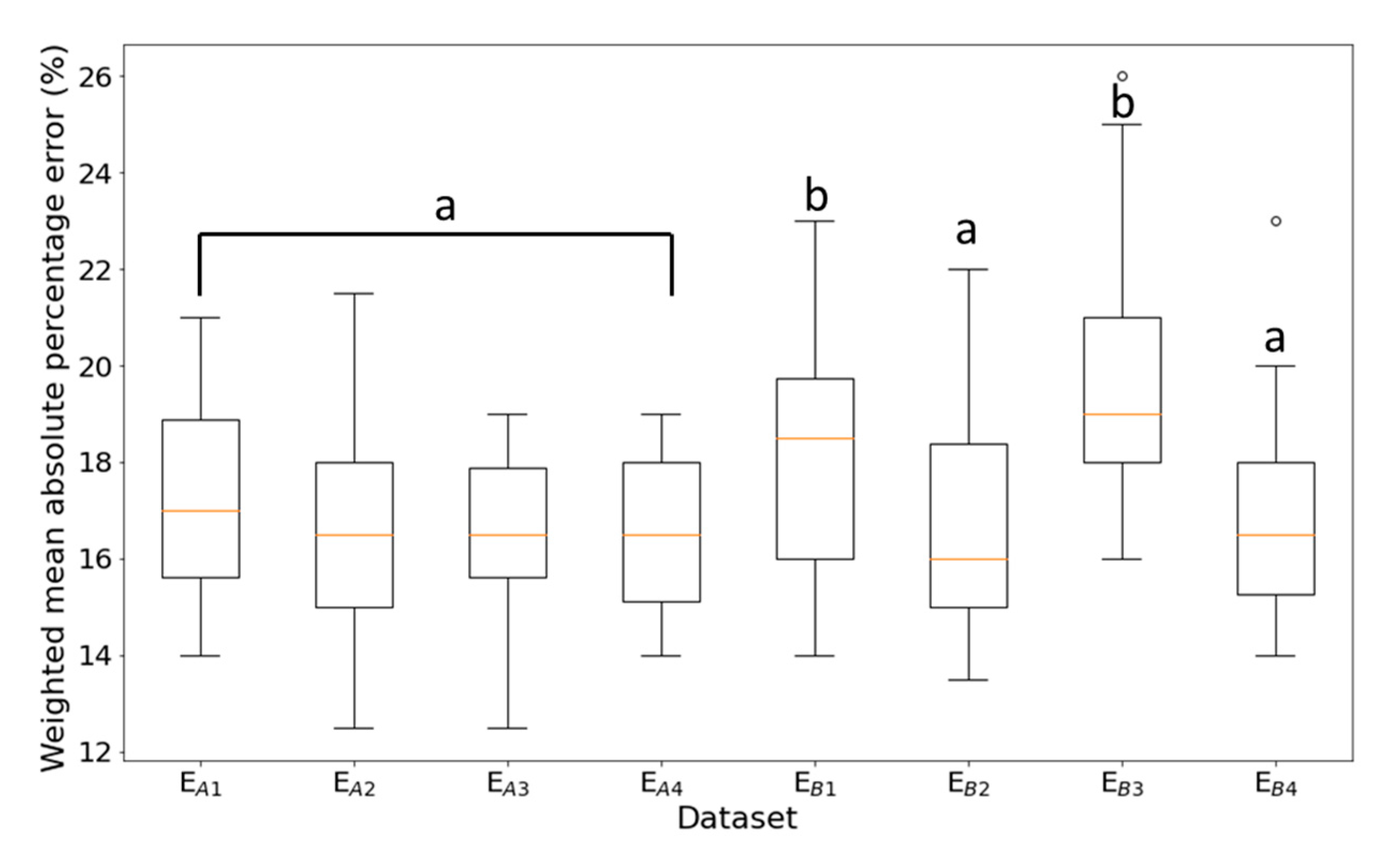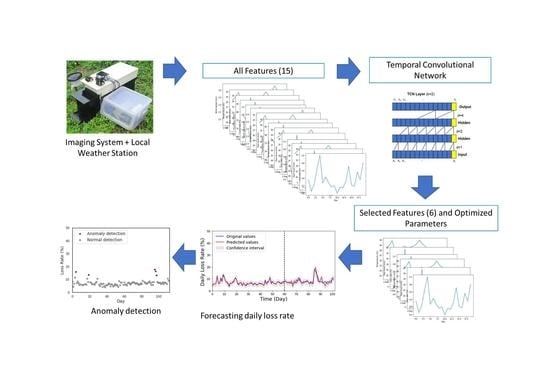1. Introduction
Honey bees (
Apis mellifera) are essential for global food production [
1]. In the last decades, some regions of the world have suffered from a significant loss in the number of active honey bee colonies [
2]. The decline of honey bee colonies is partly attributed to a phenomenon known as Colony Collapse Disorder (CCD) [
1,
2]. To maintain healthy and thriving honey bee colonies, it is essential for beekeepers to regularly monitor the status of the bee hives. Currently, most beekeepers manually estimate the health of a honey bee colony in a relatively time-consuming and imprecise approach by beehive inspection and honey bee flight activity observation at the hive entrance. Automated monitoring system are highly desirable to have a rapid and quantitative access to the health status information of honey bee hives.
Various systems for automatic in-hive and hive-entrance monitoring of honey bee activities have been developed. Reported systems use infrared sensors [
3], radio frequency identification (RFID) tags and readers [
4,
5], and imaging sensors [
6]. In our recent work, we described an embedded image monitoring system for automatic and highly reliable counting of incoming and outgoing honey bees at the hive entrance [
7]. The obtained access to in-time and quantitative data opens a path to the development of forecasting models as an essential tool for beehive management, which is discussed here. When the daily population loss rate exceeds a critical threshold, the system can release an automated alert of a required and immediate intervention by the beekeeper to promptly prevent honey bee colony collapse.
An automatic system for monitoring and forecasting honey bee activity and daily loss rate has several advantages. An automated system reduces labor costs in maintaining the health of a colony [
1] and enables the identification of abandoned or collapsed hives [
8]. It can also detect quantitative deviations from a predicted normal status, as through the invasion of predators such as a hornet, the presence of pesticides in harvested areas, or strong fluctuations in environmental conditions. Forecasting models may also be used to investigate the environmental variables that largely affect the health of a honey bee colony [
9].
The collection of long-term activity data on honey bee colonies is difficult. Only few studies related to forecasting honey bee activity are reported. An early detection system was developed by Ferrari et al. [
10] for swarm monitoring by recording the auditory activity of honeybees. A microphone and a temperature and humidity sensor were installed inside the beehive. The recorded audio signals were used to predict swarming. In the work of Clarke and Robert [
9], a model was developed to predict the hourly egress rate of honey bees from local weather data such as: temperature, solar radiation, atmospheric pressure, humidity, rainfall, wind direction and wind speed. About 78% of the observed variation in honey bee activity could be explained by variations in temperature and solar radiation. In a study by Bagheri and Mirzaie [
11], a mathematical model was developed to predict the effect of pollen on honey bee colony failure, whereas Gomes et al. [
12] developed a method for forecasting the hourly activity level of honey bees using a recurrent neural network (RNN). Environmental factors, such as temperature, solar radiation and barometric pressure, together with the history of honey bee activity, were used to train the forecasting model producing a root mean square error of 0.2.
There are several possible ways in performing time series forecasting. Statistical methods include autoregressive integrated moving average (ARIMA) [
13] and Bayesian algorithms [
14]. Machine learning techniques, including random forest and support vector machine, are promising explicitly for more complex datasets [
15]. Honey bee daily loss rate is a complex and dynamic model involving different variables inside and outside the beehive. Statistical and machine learning approaches may not be adequate for complex pattern recognition. Increasingly, more researchers were able to use deep learning models for obtaining accurate and reliable forecasting results. Most deep learning models for time-series forecasting comprise recurrent neural networks (RNN). RNNs are based on mechanisms such as gated recurrent units (GRU) [
16] and long-short term memory (LSTM) [
17,
18]. Another form of neural network for time-series forecasting is the temporal convolutional neural network (TCN) [
19]. TCN was first introduced by Lea et al. [
20] for video-based action segmentation. TCN provides a unified approach for hierarchically capturing data relationships with different levels of information.
Warning level categories to classify forecasted loss rates can provide insightful information to beekeepers. In the work of Bayuadji et al. [
21], a flood warning level was determined by fitting flood and rainfall data to a logistic regression model. Thereby, pre-set probability thresholds classified rainfall into three warning levels. On the other hand, Zhang et al. [
22] used K-means clustering algorithm to classify warning levels for recorded vegetable insect pest populations from level I to level IV, being the highest warning level. Up to now, there is no related work for defining warning levels for honey bee collapse.
This work aims to develop a honey bee colony daily population loss rate forecasting method, and based on the results, define warning levels. To meet these goals, specific objectives to be fulfilled included: (1) developing a TCN model for forecasting honey bee colony daily population loss rate; (2) optimizing the developed TCN model by finding its ideal hyperparameters and determining its best input features; (3) implementing an outlier detection method, such as an isolation forest algorithm, to classify the forecasted daily population loss rate as normal or abnormal; and (4) evaluating the developed TCN model and isolation forest algorithm based on test datasets. The developed method can be used by beekeepers, entomologists, and agronomists to obtain fast, essential information about the status and abnormality in honey bee colonies.
4. Discussions
The abnormal daily
LR of the honey bee colonies in this study was about 13%, in agreement with related literature [
30,
31]. In the work of Rumkee et al. [
30], it was found that a colony will collapse if the daily mortality of forager honey bees exceeds 15% and was equally observed for both collapsed beehives (E
B1, E
B3) in this study (
Figure 9e,g).
Our experiments show that honey bee colony collapses can be predicted. Previous studies identified the collapse of honey bee colonies was most likely caused by in-hive colony behavior and health of the honey bees [
31]. A typical in-hive anomaly is caused by the loss of a queen bee. Indicators of a queen-less colony include missing eggs and brood, increased number of drones, a significant drop in population, and stored pollen and honey in the brood cells. These indicators were observed from the two collapsed beehives in the present study. Based on our recorded data, the loss of the queen occurred at about day 105 of E
B1 and day 95 of dataset E
B3. According to Lopes et al. [
33], workers of queen-less colonies can live up to 80 days. This was similarly observed in our study which shows that the colony collapsed about 60–80 days after the queen disappeared (
Figure 6a,b).
There are no strict conventions for defining the LR threshold of a collapsed honey bee colony. Based on the experimental results obtained, the daily loss rate of the beehives became abnormal or several consecutive days, which was about 50 and 60 days for dataset EB1 and EB3, respectively. The presence of an abnormal status as automatically classified is a strong indication for the required interference of beekeepers at early stage to prevent further damage to the honey bee colony.
5. Conclusions
A reliable method for forecasting and early detection of abnormal honey bee colony population loss rate is presented. The proposed method was optimized by appropriately selecting informative features and tuning the hyperparameters of a TCN forecasting model. The forecasting model performed best by using selected features, such as daily population loss rate, incoming counts, difference in counts, temperature, humidity, precipitation, and the forecasted following day’s temperature, humidity, and precipitation obtained from the local weather station. Upon comparison with other selected feature groups, it was discovered that using the forecasted weather data as supplemental input feature improved the model performance. It was also found that the forecasting model performed well by training it with at least 80 days of historical population loss rate data. The forecasting model was able to accurately forecast the following day’s honey bee colony population loss rate with a WMAPE of 17% to 19%. The forecasting model optimization strategy can be used as a reference for researchers to effectively improve their model.
The population loss rate data output of the forecasting model was further utilized to define the warning levels using an isolation forest algorithm, thus enabling the proposed method to determine whether the beehive colony status to be normal or abnormal. By validating the obtained values with the results of related works, it was found that the warning level determination method was able to yield an accuracy of 90.0 ± 8.6%.
Although the exact reason why a honey bee colony collapsed remained unclear, the data of the image monitoring system were successfully utilized to train a forecasting model that can potentially explain the phenomenon. If the daily loss rates were abnormal for a certain number of consecutive days, it indicated that honey bee collapse may potentially occur. The proposed method, together with the image monitoring system, was proven to assist in the early detection of collapsed honey bee colonies. This work can be used to deliver fast and reliable data-driven information to honey bee colony managers so that they can ensure the health of their honey bee colonies.
To actualize the system, an early warning can be determined by detecting abnormal daily loss rates while a notification can be sent to the beekeeper via mobile phone. Upon receiving the message, beekeepers can check the beehive and prevent potential harm to the honey bee colony. Beekeepers can install the monitoring system in selected beehives and monitor the beehive health index remotely.
